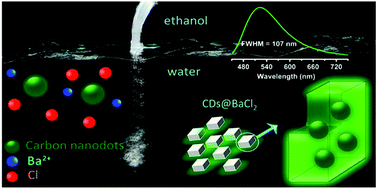A rapid in situ synthesis of wide-spectrum CD@BaCl2 phosphors via anti-solvent recrystallization for white LEDs†
Abstract
The development of solid-state carbon dots with good photoluminescence performance both at room temperature and high temperature is still challenging. Herein, we apply a facile and rapid anti-solvent-induced in situ recrystallization where the carbon dots act as the seeds of heterogeneous nucleation to encapsulate them into barium chloride crystals. Benefiting from the spatial confinement effect of barium chloride, the carbon dots are well separated in the recrystallized barium chloride crystals, thereby inhibiting the non-radiative electron–electron energy interactions between the aggregated carbon dots, presenting a wide-spectrum (FWHM = 107 nm) solid-state green-emission. Impressively, the carbon dot@barium chloride shows excellent photoluminescence thermal stability that at 423 K the intensity can maintain ∼90% of the initial intensity at room temperature, due to the low electron–electron/electron–phonon non-radiative energy transfer between the carbon dots and barium chloride. Further, the practicability of solid-state carbon dot@barium chloride phosphors was demonstrated by a series of fabricated white light-emitting-diode prototypes, in which the increment in the wide-spectrum green phosphors improved the color rendering index of the prototypes from 78.6 to 89.1. The facile synthesis process and favorable photoluminescence features will shed light on the further development of environment-friendly carbon-dot-based composites for various solid-state optoelectronic devices.

- This article is part of the themed collection: 2020 Inorganic Chemistry Frontiers HOT articles


 Please wait while we load your content...
Please wait while we load your content...